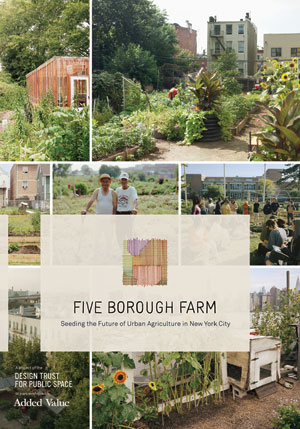 Although there are 700 urban farms and gardens spread throughout New York City’s five boroughs, urban farming there still feels ad-hoc, somewhat tacked-on in many places. The gains have been slow and future progress isn’t guaranteed.
Although there are 700 urban farms and gardens spread throughout New York City’s five boroughs, urban farming there still feels ad-hoc, somewhat tacked-on in many places. The gains have been slow and future progress isn’t guaranteed.
To boost the long-term prospects of urban farming in the U.S.’s biggest city, the Design Trust for Public Space and its partner, the Red Hook-based nonprofit Added Value, just launched a new report some three years in the making called “Five Borough Farm: Seeding the Future of Urban Agriculture,” along with a companion website. The project seeks to create a comprehensive “road map” with the goal of helping stakeholders — policymakers, community groups, farmers, and designers — “understand and weigh the benefits” of urban agriculture, while making a compelling case for significantly ramping up local government support for this growing field. Basically, if you’ve been looking for a thorough examination of all the policy aspects of urban farming, this is it.
The Design Trust for Public Space has had a long history of strategically intervening in the public realm in New York City. It was a very early supporter of the vision of the High Line founders, and the group has recently been involved in redesigning New York’s taxis and creating sustainable guidelines for the city’s parks, buildings, and infrastructure.
The report’s authors argue for a comprehensive policy approach to urban agriculture because so many of New York’s urban farms are on city land. A “decentralized system of diverse, small-scale, community-based public spaces” exists in schoolyards, the grounds of public housing developments, community gardens, and public parks, the report reads. As we know, the benefits of these spaces go beyond fresh produce. The American Society of Landscape Architects’ recent Google Sketch-up animation — The Edible City — explains how gardens improve the health and well-being of communities and help people better engage with their urban environments. But, unfortunately, in New York and so many other cities, there’s still a disconnect between official policy and the bottom-up grassroots movement being led by gardeners, farmers, and landscape architects.

Photo by Design Trust for Public Land and Added Value.
To remedy this, the Design Trust brought together nearly 100 experts in food policy, sustainable design, and public health. It looks like just about every major urban farm, community gardening group, and nonprofit working on food issues participated, which gives their recommendations some real weight.
First, the group identified some of the obstacles to future growth. For example, farmers and gardeners face a whole host of “challenges obtaining critical resources” such as soil, compost, and growing space, as well as construction materials, financing, and skilled labor. More involvement by city farmers in policy making could help alleviate some of those problems. Additionally, the group identified some “race- and class-based disparities that hinder access to information, services, and funding” among urban farmers. In other words, depending on where they are, neighborhood farmers in New York may get very different treatment. Furthermore, the city is doing very little to actually track urban agriculture, so there’s no good data on the scope of the field or its growing contribution to the city’s economy. Without a better understanding of how urban agriculture creates social, ecological, and economic benefits, it’s hard to build more support for these farms. Lastly, the report says that the city government has little authority over coordinating urban agriculture, nor does it appear to be incorporating these programs into other complementary initiatives.
The Design Trust for Public Space and Added Value smartly focus on the need for better metrics. They write that while there are now tons of studies showing the benefits of urban farming, there is no way to track real progress on improving healthy eating, spurring physical activity, growing jobs, and building “community cohesiveness.” As a result, they propose a whole set of indicators that the city should be methodically collecting data against annually. And to track this data well, the city will need to ramp up its own resources, with an enhanced position for the “food policy coordinator,” whose success should then be tied to the growth of the burgeoning field. [Read a related Grist post about urban farm data collection.]
The report’s recommendations, which are detailed over many pages, fall into a few categories. The first involves boosting the resources for urban agriculture in New York City’s government. The group proposes strengthening the city’s GreenThumb program, while making the food policy coordinator a true urban farming czar for the city. The second looks at how urban agriculture can be better integrated into city policies and plans. For example, shouldn’t urban agriculture be better connected with New York’s innovative green infrastructure program, which just received almost $200 million in financing? Maybe all those green streets could also be used to grow tomatoes. The third explores how the city’s vast roofscape could be better used for farming. Stalled development sites, new developments, and existing buildings that can handle the structural load should all be real opportunities for rooftop farms, like the innovative Brooklyn Grange. The last set of recommendations examines how disparities based on class or race could be better addressed, with more capacity building and information resources for poorer areas of the city.
Even if you don’t live in New York, this well-designed, well-written 170-page report is certainly worth exploring, perhaps as a model for a similar urban agriculture plan in your own city. You can see some of it online or buy it online. You can also read an interesting interview with Susan Chin, executive director of the Trust, by Metropolis Magazine editor Susan Szenasy, or one with Nevin Cohen, lead writer of the report, by Urban Omnibus.



